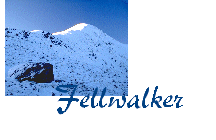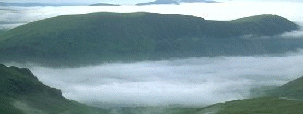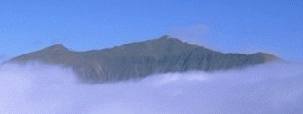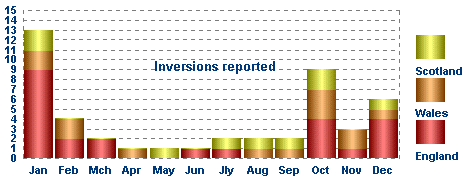
Inversions aloft
(Please use browser back button to return)

Ground inversions


A
cloud
sea must surely give some of the finest hillwalking conditions, walking
in often crystal clear air above valleys hidden below the swirling
cloud
tops or blurred under a layer of hazy polluted air.
Modest
British hills can feel positively Alpine!
And
the
expectations, first plodding up in thick mist, then sensing a
brightness
in the cloud above the pace quickens with the pale disk of the sun
intermittently
visible through the cloud. Will it be low enough? Should I have chosen
a bigger hill? Suddenly clear air bursts in, distant hills are revealed
as islands in this all too temporary and rare ocean..the day will be a
classic!
Inversions
come in two types, the early morning valley fog type being quite
common,
the inversion aloft being the rarer and more desirable condition.
Ground
or nocturnal Inversions
Mountain
areas often produce morning valley fog after a clear night where air
near
the damp ground has cooled by radiation. As the cool air is heavier it
stays in the valleys, leaving the tops in clear warmer air. The sun
will
normally destroy this effect within a few hours of rising.


Stratus
cloud forming in valley bottom in early morning
Inversion
aloft
Rarer
is an inversion aloft, which may last all day, and is typified by warm
clear air and blue skies above thick low cloud. A layer of warmer air
exists
between colder air below and above (possibly caused by anticyclonic
subsidence
or cool sea breezes undercutting warmer air [sea breeze inversion]). If
this layer dips below summit level clouds at the top of the lower cold
layer will appear as a cloud sea from summits.


Inversion
at about 2500' on Snowdon (present all day)
How
do
I recognise one from valley level?
The
only
possible indicators I am aware of are:-
High
pressure,
very low cloud or fog - without precipitation*, possibly combined with
low wind strength, although the one photographed on Snowdon above had a
strong breeze below the inversion and still air in the warm layer.
*I have report of inversion on Cuillin with drizzle in Glenbrittle.
When
do
they occur?
Autumn/Winter
mornings coupled with the presence of a high pressure system seems to
be
the best time.
A meteorologist tells me that May is peak for inversions, but it seems they do not often occur low enough
in the atmosphere to be of significance to hillwalkers at that time.

Mountain
Weather David Pedgley Cicerone 1980 (second
edition
now available)
Mountaincraft
and Leadership (in part)Eric Langmuir
Scottish
Sports Council 1984